“It looks so good on the model… But how will it look on ME?”
With more and more of our buying activity happening online, the MyBodyModel custom croquis can be used as a virtual fitting room for internet clothing shopping. I originally wanted my own personal fashion templates for planning my knitwear, for adapting patterns to make adjustments for my body. It’s become just as fun to use for choosing ready-to-wear clothing.
Drawing sketches on my me-shaped template is a way to virtually “try on” clothing before I buy and choose which styles to order, when overwhelmed with all the possible choices the web offers.
Personally, I gravitate toward some quirky fashion: asymmetrical shapes, boho looks, prints, and details that run more to “fussy” than simple. I’m also plus-sized, so many times, the clothing I purchase is depicted on websites modelled on thin fashion models, and it can be hard to visualize how a look will scale to a different figure. These two things in combination, my preference for not-so-conservative fashions on my not-so-conservative body, can be tricky, and I’ll admit, there have been a large number of speedy returns in the history of my online shopping. But lately MyBodyModel has been coming in handy.
Here’s my new process to make better shopping decisions, using a recent online purchase as an example.
Virtual fitting room Step 1: start with quick small sketches, focusing on basic shape & proportions
I do my drawings in pencil to start, and on the page with multiple templates in the smallest size. Sometimes they’re just light and scratchy drawings of the basic proportions of garments that have caught my attention online. Working small means I have to focus on the primary shape, and leaves no room to get lost in details. Once I’ve sketched, I go back over the lines with a felt tip pen.
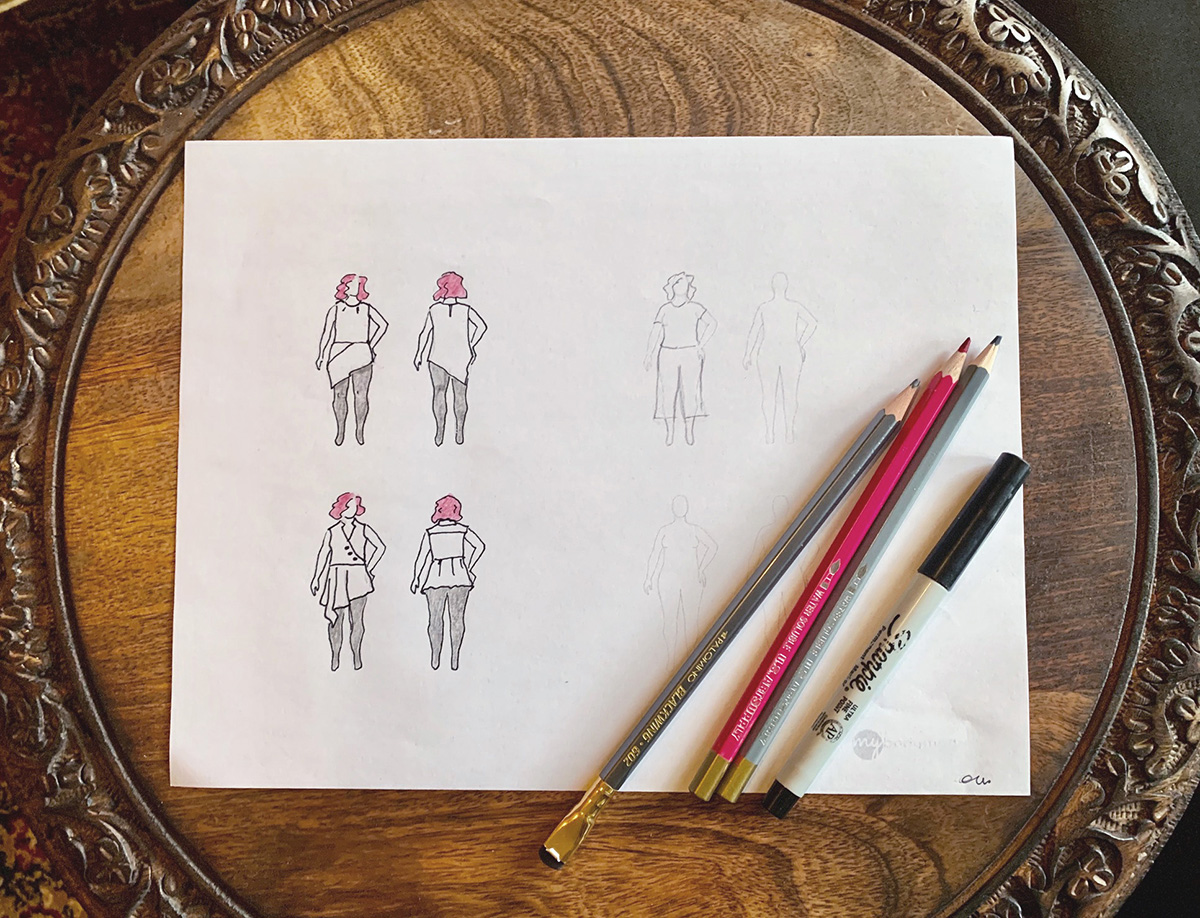
For the illustrations here, I’ve used clothing from Eshakti for the following reasons:
- It’s a true mainstay of my personal online shopping.
- They offer an inclusive range of sizes, from 0 to 36, XS to 6X.
- They provide alterations and customizations, so if, by sketching, I discover I’d prefer a different hem length, sleeve, or neckline, Eshakti can provide that adjustment on the finished garment for a modest fee.
Asymmetric styles are one of my favorites, so much so that on the Eshakti site I use that as a frequent search term to find new looks I might like. This season, they offered a couple of shirts that I took into consideration, in small sketches:
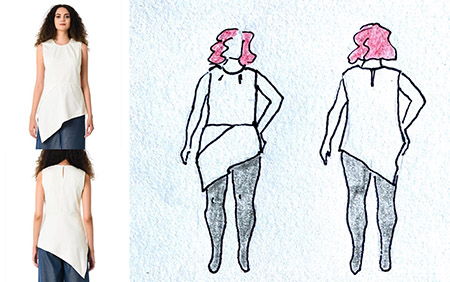
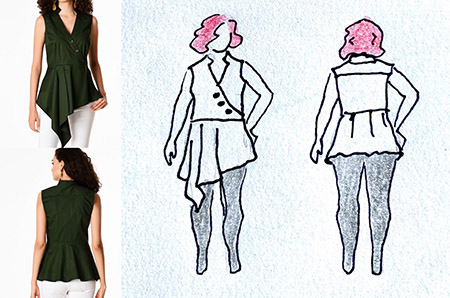
A few things become noticeable about these garments as I draw: one blouse is asymmetric both front and back, while the other has a more conventional peplum waist on the back to balance out the dramatic gather on the front. Even in these tiny sketches, I can tell that I prefer the more gathered option, that the smoother one reads visually as a solid trapezoid block. But in both cases, I think the strong angles make it hard to match the shirt to the right pants or skirt. See how I’ve even left my little croquis in her tights? It’s like I realized, in the exercise of sketching, that nothing from my wardrobe steps up as the right match for either garment. Many, many times, sketching out my “shopping cart” from an internet fashion website onto the MyBodyModel sketch page helps me decide not to purchase any of the garments I’ve been browsing.
I decided to look instead at full dresses with asymmetrical features, using the medium-sized croquis (3-models per page printable template).
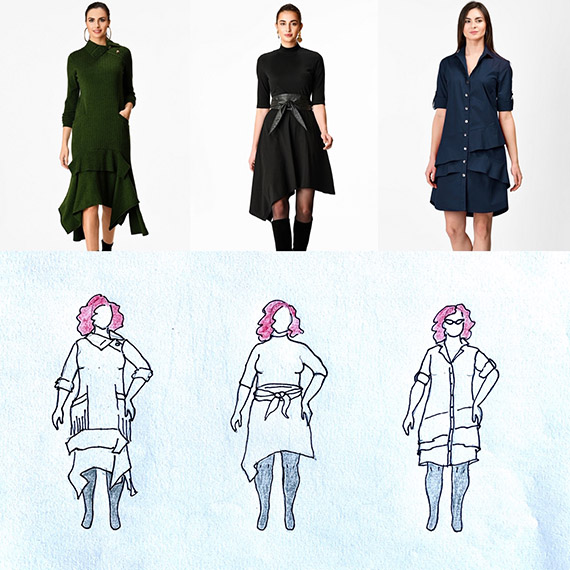
3 drawing tips for your own virtual fitting room:
- Look at the overall shape and proportions of the garment.
- Pay special attention to where necklines, hems, and seams fall. Do the shoulders sit on the natural shoulder? Or do they hang farther down the arm? Try to place the seams at the same point on your body template.
- Use the lines of the croquis for any garments that are close-fitting, like knitwear. The dress above on the left is a ribbed sweater dress, so I tried to follow the template lines closely. For the stiffer poplin fabric of the dress on the right, I create new lines just outside the croquis–or added bulk in areas like the rolled-up sleeves.
My sketches are far from perfect in proportion or detail, but you can see how these little paper doll renderings start to make it easier to imagine styling and wearing the garments.
Note that I prefer to keep the garments in outline form in my drawings, because that makes it easier to focus on the lines, proportion, and shape of the garment. Coloring them can be fun but it distracts, and biases my judgement in favor of my favorite colors, when I’m trying to find the right proportion and shape for my body.
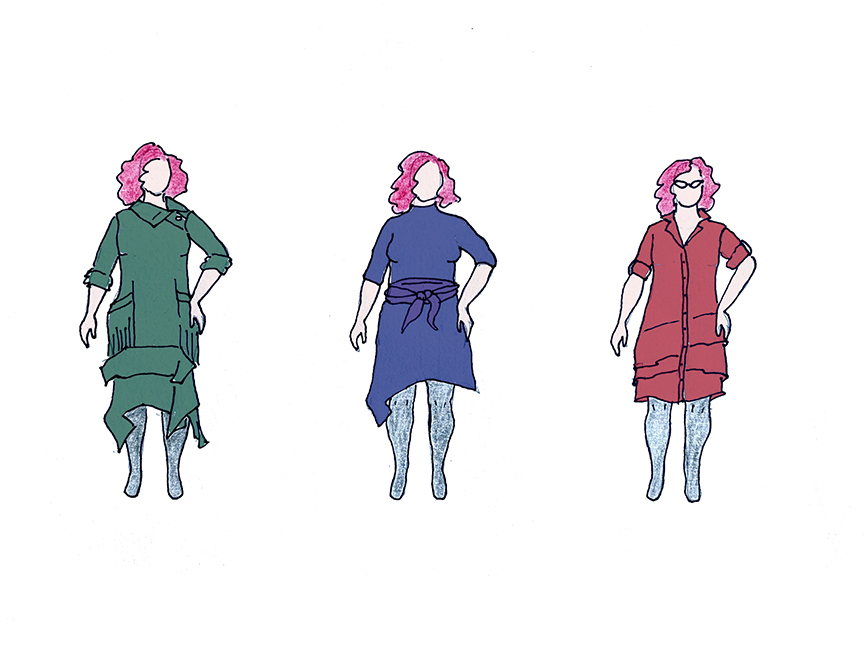
Virtual fitting room Step 2: A more detailed sketch, just to make sure
When I like the way a dress or outfit looks on the smaller croquis sketch, then I take a look at the larger scale drawings, and maybe double-check both the front and the back:
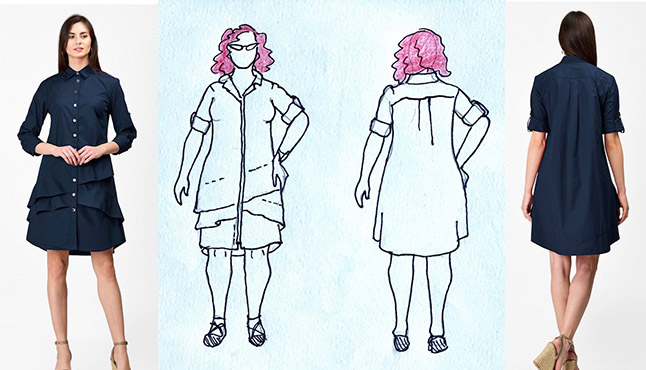
As you can see, using the MyBodyModel template as a virtual dressing room is not only about envisioning the finished product, It’s also about the way that drawing focuses my attention on the details of the garment and how I feel about wearing each feature. It makes my shopping more considered, just for taking the time to think through the item in pencil and pen.
And how did it turn out, you may wonder? Here’s the sketched version, and the actual dress after it arrived!
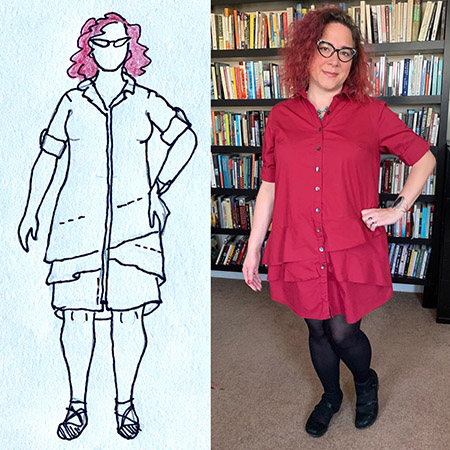
Note that I drew the hem a little too long, but the finished dress is quite true to the original photo. Drawing is inexact. But the proportions and style did give a good visual indication of how the fit of the dress would actually turn out, in any color.
With practice, using the MyBodyModel for a variety of projects, I’ve gotten better at visualizing clothing I see on professional models adapted for my particular shape.
Sometimes I’ll look at some seductive item on a website and merely open my sketchbook, look at the first little row of figures, and know right away “hmm, that’s not going to work out like I want it to.” But when I take the time to draw a garment and I really like the way it looks in drawn form, I am far more likely to be satisfied with the clothing I buy.
Sketching takes one more level of risk out of shopping for clothing online. I shop with more confidence that what I choose will look good on me, too.
Have you tried sketching on your body model to help you make better online shopping decisions? Let us know in the comments below!
See how Julie uses MyBodyModel to plan her knitting projects
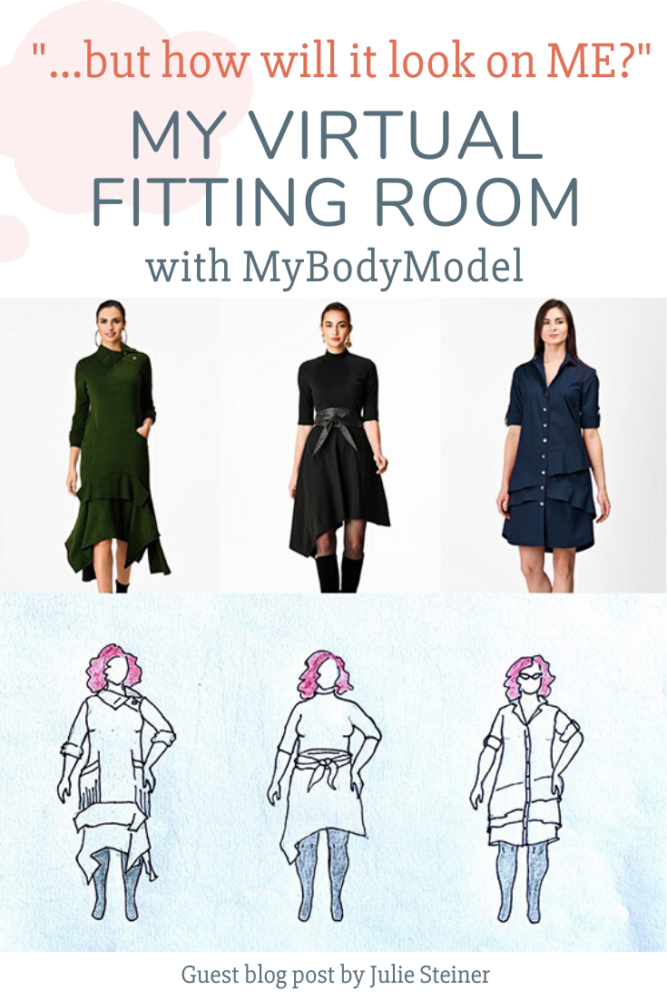
Are you on Pinterest or other social media? Please help more people discover MyBodyModel by sharing this post! Thank you!!
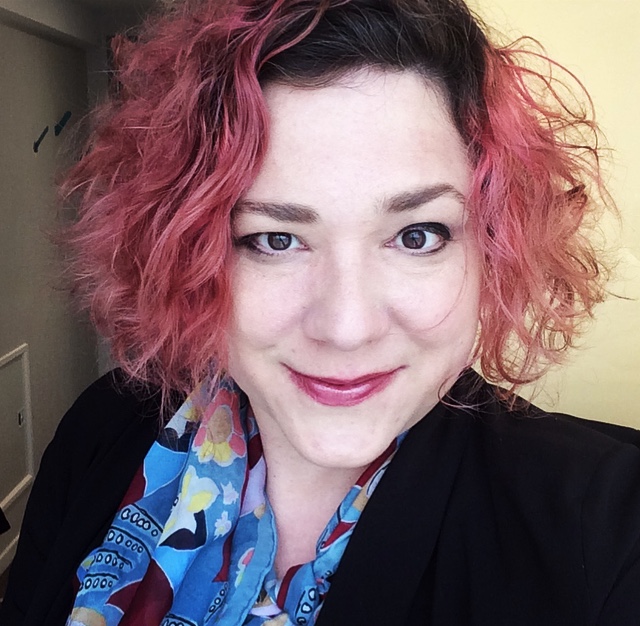
Museum professional by day, knitter by night, normally Julie Steiner writes about fine art and the business of museums. She has, along the way, probably knit more sweaters than she can wear in a lifetime. Julie lives in West Philadelphia with her husband, a cousin, and an elderly chihuahua. Like other knitter/bloggers of her demographic, Julie predictably loves gardening, reading, travel, vegetarian cooking and fluffy animals, believes in flossing and calling/writing elected officials. Find her finished knitting projects on Ravelry and follow her wanderlust and other pursuits on Instagram, both as @rljulie.
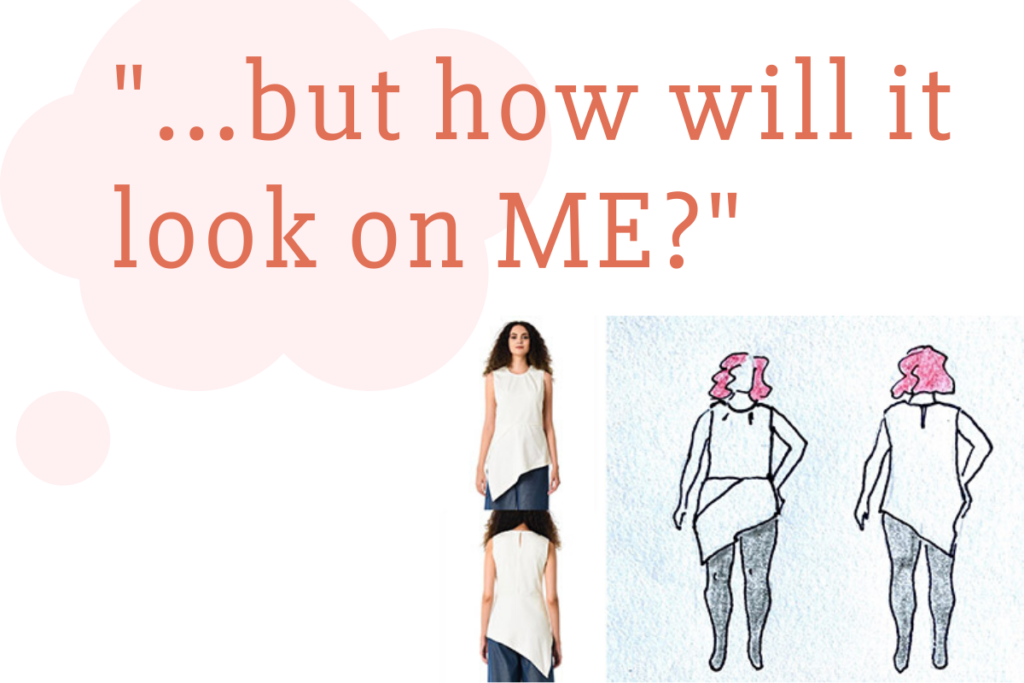

5 thoughts on “My virtual fitting room for online clothes shopping, by Julie”
Such a useful post! Thanks for sharing.
So how do you make sure the scale of the garment matches what you are sketching? Are you finding finished measurements for the online garments and somehow matching that in your sketch?
That’s a good question, Alison Marie. Personally, I go by the fit of the models—so if a garment is shown oversized and slouchy on a thin model, I presume that if I buy the size that fits my own measurements, the item will also be oversized and slouchy on me. If it’s more tailored and close-fitting, I draw it that way. So it really is only as scientific as matching seams to body parts, as shown in the available modeled photos.
I suppose one could size up down for more creative variation, but I tend to look pretty closely at size measurements and buy the sizes in each brand that are closest to my own measurements.
This is a lovely article. Its so nice to hear about others who take such care in shopping for clothes and how the body model product can be so useful.
I’m also extra, Julie. Love those colors, doo-dads, daring cuts and more. Some would say “unfortunately” because I’m 65, live in a sweatshirt and jeans agricultural town where I’ve been cheerfully over dressing for 25 years. AND I’m bipolar so yes, its all over the top. Toss forth the glitter!
However, I’m into good tailoring, natural fabrics and navy blue will ever be my neutral anchor. I draw the line at looking bizarre, if only for the sake of many grandchildren. I thrift a lot, plenty to have inventory to work on through the 2nd coming. Plenty of navy. And sequins.
Again, thanks for your thoughtful, well-written article. I’ll be following on IG. I’m @RedeemedStyle.
This is such a brilliant idea! Also, a great way to be a bit more environmentally friendly – all the shipping and returns add up!